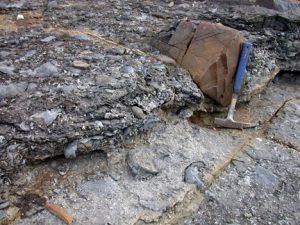Permian Climate and Seawater Composition using the Chemistry of Fossils
Paleoclimate work in Earth’s deep past has been limited by uncertainty about the meaning of unexpectedly low δ18O values from ancient marine carbonates. Increasingly negative values with increasing age could indicate very warm depositional temperatures, more negative seawater compositions, or pervasive alteration of the original carbonate. A significant impediment to progress has been the inability to convincingly demonstrate that the oxygen isotope values of carbonate retain their primary signal of depositional conditions. High-resolution microsampling of accretionary shell carbonate may offer a resolution to this aspect of the debate. Shells that demonstrate seasonal variation in isotope values along the growth trajectory can be more reliably interpreted as primary.
Micromilled data from the early Permian high-latitude bivalve Eurydesma from SE Australia show clear and consistent seasonal variation over 5-6 years of shell growth, suggesting primary compositions. Independent temperature control from associated glaciomarine sediments and glendonites require winter temperatures near freezing and therefore allow for determination of seawater δ18O. Shells arrayed over 11° of paleolatitude illustrate a trend toward more negative winter shell values and generally decreasing seasonal amplitude of water temperature moving toward the pole. Isotope data suggest seawater values decreased from -3 to -5 per mil with increasing latitude, significantly more negative than modern open marine values. This implies a much steeper gradient in the composition of seawater with latitude than today, mixing of depleted meltwater, and/or an overall more depleted ocean than today. Additional sampling to increase geographic coverage will help discriminate among these possibilities.
Collaborators
- Bruce Runnegar (UCLA)
Student Research
- Andrew Beard (M.Sc.) “Regional variation in seasonal oxygen isotope values of Permian bivalves from Southeastern Australia”
Publications
(*student author)
Ivany, L.C. and Runnegar, B. (2010) Early Permian seasonality from bivalve δ18O and implications for the oxygen isotopic composition of seawater. Geology v. 38, pp. 1027-1030.
Beard, J.A., Ivany, L.C., and Runnegar, B. (2015) Gradients in seasonality and seawater oxygen isotopic composition along the Early Permian Gondwanan Coast, SE Australia. Earth and Planetary Science Letters, v. 425, pp. 219-231. doi:10.1016/j.epsl.2015.06.004



